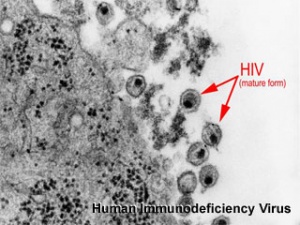Abnormal Development - Human Immunodeficiency Virus
| Embryology - 28 Apr 2024 |
|---|
| Google Translate - select your language from the list shown below (this will open a new external page) |
|
العربية | català | 中文 | 中國傳統的 | français | Deutsche | עִברִית | हिंदी | bahasa Indonesia | italiano | 日本語 | 한국어 | မြန်မာ | Pilipino | Polskie | português | ਪੰਜਾਬੀ ਦੇ | Română | русский | Español | Swahili | Svensk | ไทย | Türkçe | اردو | ייִדיש | Tiếng Việt These external translations are automated and may not be accurate. (More? About Translations) |
| Educational Use Only - Embryology is an educational resource for learning concepts in embryological development, no clinical information is provided and content should not be used for any other purpose. |
Introduction
The human immunodeficiency virus (HIV) is a retrovirus that causes Acquired Immunodeficiency Syndrome (AIDS). Maternal transmission of HIV can occur perinatally in utero, during labour and delivery, or postnatally through breastfeeding and can be reduced by the use of antiretroviral treatment and avoidance of breastfeeding.
Neonatal infection diagnosis can be made by PCR from 6-12 week.
UNAIDS, the Joint United Nations Programme on HIV/AIDS, estimated that 38.6 million people had HIV (2005), 17.3 million were women. About 3.28 million pregnant women infected with HIV give birth each year (the majority in sub-Saharan Africa) leading to 700,000 new infections of HIV in children each year. (text modified from Gray and McIntyre, BMJ 2007;334:950-953)
Some Recent Findings
|
| More recent papers |
|---|
|
This table allows an automated computer search of the external PubMed database using the listed "Search term" text link.
More? References | Discussion Page | Journal Searches | 2019 References | 2020 References Search term: Maternal HIV <pubmed limit=5>Maternal HIV</pubmed> |
History
References
Reviews
<pubmed></pubmed> <pubmed></pubmed> <pubmed></pubmed> <pubmed>22155898</pubmed> <pubmed>21643782</pubmed> <pubmed>21284900</pubmed> <pubmed>21078445</pubmed> <pubmed>19706669</pubmed>
Articles
<pubmed></pubmed> <pubmed></pubmed> <pubmed>23217137</pubmed> <pubmed>22690108</pubmed> <pubmed>22129112</pubmed>
Search Pubmed
Search Pubmed: Human Immunodeficiency Virus | embryo infection | fetal infection |neonatal infection
| Environmental Links: Introduction | low folic acid | iodine deficiency | Nutrition | Drugs | Australian Drug Categories | USA Drug Categories | thalidomide | herbal drugs | Illegal Drugs | smoking | Fetal Alcohol Syndrome | TORCH | viral infection | bacterial infection | fungal infection | zoonotic infection | toxoplasmosis | Malaria | maternal diabetes | maternal hypertension | maternal hyperthermia | Maternal Inflammation | Maternal Obesity | hypoxia | biological toxins | chemicals | heavy metals | air pollution | radiation | Prenatal Diagnosis | Neonatal Diagnosis | International Classification of Diseases | Fetal Origins Hypothesis |
External Links
External Links Notice - The dynamic nature of the internet may mean that some of these listed links may no longer function. If the link no longer works search the web with the link text or name. Links to any external commercial sites are provided for information purposes only and should never be considered an endorsement. UNSW Embryology is provided as an educational resource with no clinical information or commercial affiliation.
- World Health Organization HIV-infected women and their families: psychosocial support and related issues. A literature review. 2003
- British HIV Association Guidelines for management of HIV and hepatitis C coinfection in adults | Guidelines for the management of HIV infection in pregnant women and the prevention of mother-to-child transmission of HIV, 2005 | Guidelines for management of HIV and hepatitis B coinfection in adults
Glossary Links
- Glossary: A | B | C | D | E | F | G | H | I | J | K | L | M | N | O | P | Q | R | S | T | U | V | W | X | Y | Z | Numbers | Symbols | Term Link
Cite this page: Hill, M.A. (2024, April 28) Embryology Abnormal Development - Human Immunodeficiency Virus. Retrieved from https://embryology.med.unsw.edu.au/embryology/index.php/Abnormal_Development_-_Human_Immunodeficiency_Virus
- © Dr Mark Hill 2024, UNSW Embryology ISBN: 978 0 7334 2609 4 - UNSW CRICOS Provider Code No. 00098G

